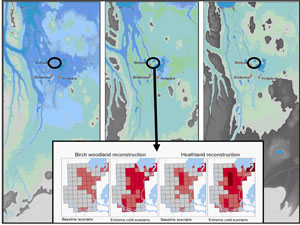
PLACE modelling
PLACE (People LAndscape, Climate and Environment) is a four-dimensional spatial model developed by Andy Casely to reconstruct and test hypotheses related to landscape, vegetation, snow, environmental change and human impact in the North Atlantic islands. The aim is to develop reconstructions at a scale that is relevant for people on the North Atlantic islands.
It originated from Casely's PhD (2006), which had the objective of disentangling the relative importance of climate versus human impact in the Medieval landscape of Iceland. PLACE is an original model of climate, mass balance and vegetation, initially developed for Iceland, but subsequently applied to the Faroe Islands and presently being adapted to Greenland. It is designed and written in Java code for the whole of Iceland at 250m grid resolution, Faroe Is at 50m and Greenland at 200m. It has generated a great deal of new data, including new modelling of snowline, mass balance, glacier ELA, potential vegetation cover and growing season. Comparisons have been made with gathered data on soil erosion and sediment accumulation, and existing settlement change, vegetation and tree cover data (Landsat and mapped). It has been tested independently in Iceland using glacier mass balance data from around Iceland, and has been applied to test hypotheses about the scale of human impact and land degradation on the Icelandic landscape (e.g. Casely and Dugmore, 2007).
PLACE has also been used in other applications - seafaring and settlement of the North Atlantic (forthcoming paper), modelling of the equilibrium line in Iceland (forthcoming paper), geomorphology in the Faroe Islands, and settlement and mobility in Greenland (current project).

PLACE and Bumodel outputs for the Mývatn area, N Iceland. PLACE outputs warmer (left) to cooler (right)
References
Casely, A.F. 2006. Medieval climate change and settlement in Iceland. PhD Thesis, University of Edinburgh. 243pp.
Casely, A.F. and Dugmore, A.J. 2007. Good for glaciers, bad for people? Archaeologically relevant climate models developed from reconstructions of glacier mass balance. Journal of Archaeological Science 34, 1763-1773.
http://dx.doi.org/10.1016/j.jas.2006.12.014